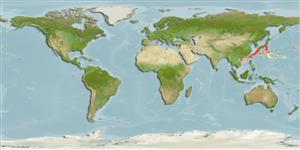Environment: milieu / climate zone / depth range / distribution range
Ökologie
seewasser bathydemersal; tiefenbereich 500 - 1985 m (Ref. 7460). Deep-water; 35°N - 34°S, 102°E - 153°W
Northwest Pacific: Japan and Taiwan; most probably in East China Sea and/or the Okinawa Trough, but rarely in the South China Sea. No reliable reports outside this area and need to be checked.
Size / Gewicht / Alter
Maturity: Lm ? range ? - ? cm
Max length : 14.0 cm SL Männchen/unbestimmt; (Ref. 559)
A species belonging to the C. fimbriatus species group which is distinguished mainly from its congeners by having two large pale patches on its dorsal surface, one associated with the embedded third dorsal spine and another before the origin of the soft dorsal fin; mainly four neuromasts in the lower preopercular series (vs. mainly 3 in other congeners) (Ref. 94130).
Benthic (Ref. 58302). Edible (Ref. 637).
Life cycle and mating behavior
Geschlechtsreife | Fortpflanzung | Ablaichen | Eier | Fecundity | Larven
Masuda, H., K. Amaoka, C. Araga, T. Uyeno and T. Yoshino, 1984. The fishes of the Japanese Archipelago. Vol. 1. Tokai University Press, Tokyo, Japan. 437 p. (text). (Ref. 559)
IUCN Rote Liste Status (Ref. 130435: Version 2024-1)
Bedrohung für Menschen
Harmless
Nutzung durch Menschen
Fischereien:
Tools
Zusatzinformationen
Download XML
Internet Quellen
Estimates based on models
Preferred temperature (Ref.
123201): 3.5 - 6.5, mean 4.6 °C (based on 54 cells).
Phylogenetic diversity index (Ref.
82804): PD
50 = 0.5000 [Uniqueness, from 0.5 = low to 2.0 = high].
Bayesian length-weight: a=0.01122 (0.00514 - 0.02450), b=3.04 (2.87 - 3.21), in cm total length, based on all LWR estimates for this body shape (Ref.
93245).
Trophic level (Ref.
69278): 3.9 ±0.7 se; based on size and trophs of closest relatives
Fishing Vulnerability (Ref.
59153): Low vulnerability (10 of 100).
